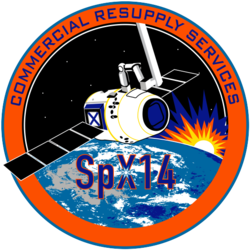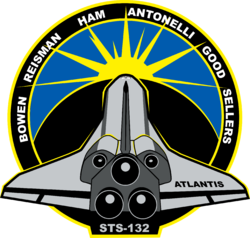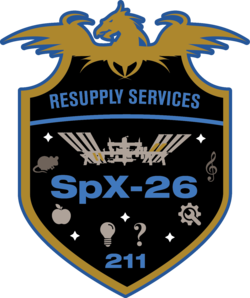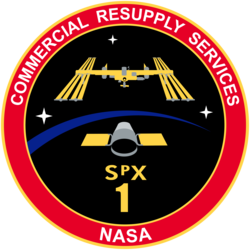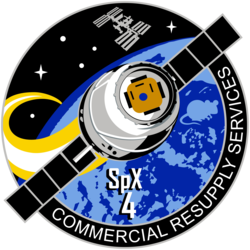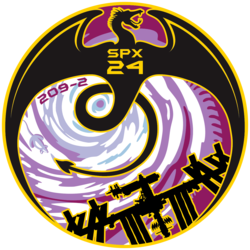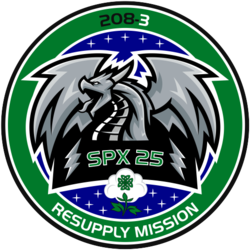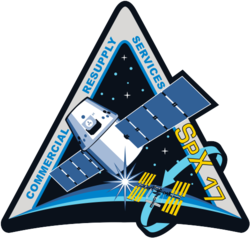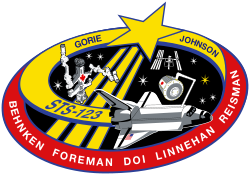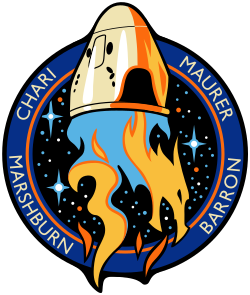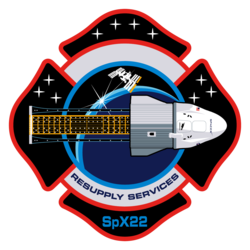Harmony (ISS)
- För andra betydelser, se Harmony.
| Harmony (Node 2) | |
 | |
| Status | Aktiv |
|---|---|
| Rymdstation | ISS |
| Beställare | NASA |
| Tillverkare | Thales Alenia Space |
| I omloppsbana | 17 år, 5 månader och 25 dagar (17 april 2025) |
| Uppskjutning | |
| Uppskjutning | 23 oktober 2007, 15:38:19 UTC[1] |
| Uppskjutningsplats | Kennedy Space Center LC-39A |
| Raket | STS-120 Discovery |
| Uppskjutningsvikt | 14 500 kg |
| Dockning | 26 oktober 2007, 15:57 UTC |
| Omplacering | 14 november 2007 |
| Mått | |
| Vikt | 15 300 kg |
| Längd | 6,7 m |
| Diameter | 4,48 m |
| Boyta | 70 m³ |
| Dockningsportar | |
| Antal portar | 6st |
| Porttyp | Common Berthing Mechanism |
| För | Pressurized Mating Adapter |
| Akter | Destiny |
| Styrbord | Columbus |
| Babord | Kibō |
| Zenit | Pressurized Mating Adapter |
| Nadir | Cygnus, H-II Transfer Vehicle, MPLM, Dragon |

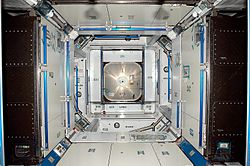



Harmony är en amerikansk trycksatt förbindelsemodul på den internationella rymdstationen ISS. Harmony är även känd under namnet Node 2, men döptes till Harmony av amerikanska skolbarn i en tävling i mars 2007.[2] I Harmony möts amerikanska, ryska, kanadensiska, europeiska och japanska komponenter på den internationella rymdstationen.
Harmony är byggd av ESA i Turin, Italien, men bekostad av NASA. Harmony levererades den 1 juni 2003 till Kennedy Space Center. Modulen bidrar med ungefär 70 kubikmeter till rymdstationens trycksatta volym. Efter installationen kunde besättningen utökas från tre till sex personer. Detta utnyttjades från och med den 29 maj 2009 då Expedition 20 påbörjade sitt uppdrag.
Anslutningar
Harmony har sex anslutningar: för, akter (bakifrån), styrbord (högerifrån), babord (vänsterifrån), zenit (ovanpå) och nadir (under). Alla är av typen Common Berthing Mechanism.
- För: Dockningsstation för NASAs rymdfärjor (Pressurized Mating Adapter) och Dragon 2 (International Docking Adapter)
- Akter: Det amerikanska laboratoriet Destiny.
- Styrbord: Det europeiska laboratoriet Columbus.
- Babord: Det japanska laboratoriet Kibō.
- Zenit: Dragon 2 (International Docking Adapter). Har använts av japanska H-II Transfer Vehicle. Skulle användas av den föreslagna modulen CAM (Centrifuge Accommodations Modul).
- Nadir: Används av H-II Transfer Vehicle och SpaceXs Dragon, samt de trycksatta transportmoduler (Multi Purpose Logistic Module, MPLM) som levereras med rymdfärjorna.
På utsidan av Harmony finns kraftförsörjd anslutningsplats för Canadarm2.
Dimensioner och vikt
Harmony är 6,7 meter lång, har en diameter på 4,5 meter och vägde ungefär 14,5 ton vid uppskjutning och i drift ungefär 15,3 ton. [2]
Uppskjutning
Harmony levererades till ISS i oktober 2007 av STS-120 som tillfälligt installerade modulen på babords sida av Unity. Expedition 16 flyttade sedan efter en serie rymdpromenader och med hjälp av Canadarm2 Harmony till sin permanenta plats framför det amerikanska laboratoriet Destiny den 14 november 2007. Därefter utförde Expedition 16 ytterligare två rymdpromenader för att slutföra installationen, varav den sista gjordes den 24 november.
Dockningar
| Farkost / Modul | Port | Dockning (UTC) | Urdockning (UTC) | |
|---|---|---|---|---|
| Unity | Akter | 26 oktober 2007, 15:57 | 14 november 2007 | |
| PMA-2 | För | 12 november 2007 | ||
| Destiny | Akter | 14 november 2007 | ||
 | Atlantis STS-122 (PMA-2) | För | 9 februari 2008, 17:17 | 18 februari 2008, 09:24 |
| Columbus | Styrbord | 11 februari 2008, 21:44 | ||
| Endeavour STS-123 (PMA-2) | För | 13 mars 2008, 03:49 | 25 mars 2008, 00:25 | |
| ELM-PS | Zenit | mars 2008 | 6 juni 2008 | |
 | Discovery STS-124 (PMA-2) | För | 2 juni 2008, 18:03 | 11 juni 2008, 11:42 |
| Kibō | Babord | 3 juni 2008, 23:01 | ||
 | Endeavour STS-126 (PMA-2) | För | 16 november 2008, 22:01 | 28 november 2008, 14:47 |
| Leonardo (MPLM) | Nadir | november 2008 | november 2008 | |
 | Discovery STS-119 (PMA-2) | För | 17 mars 2009, 21:19:53 | 25 mars 2009, 19:53:44 |
 | Endeavour STS-127 (PMA-2) | För | 17 juli 2009, 17:47 | 28 juli 2009, 17:26 |
 | Discovery STS-128 (PMA-2) | För | 31 augusti 2009, 00:54 | 8 september 2009, 19:26 |
| Leonardo (MPLM) | Nadir | september 2009 | september 2009 | |
| HTV-1 | Nadir | 17 september 2009, 22:26 | 30 oktober 2009, 15:02 | |
 | Atlantis STS-129 (PMA-2) | För | 18 november 2009, 16:51 | 25 november 2009, 09:53 |
| PMA-3 | Zenit | 25 januari 2010 | 16 februari 2010 | |
 | Endeavour STS-130 (PMA-2) | För | 10 februari 2010, 05:06 | 20 februari 2010, 00:54 |
 | Discovery STS-131 (PMA-2) | För | 7 april 2010, 07:44 | 17 april 2010, 12:52 |
| Leonardo (MPLM) | Nadir | april 2010 | april 2010 | |
 | Atlantis STS-132 (PMA-2) | För | 16 maj 2010, 14:28 | 23 maj 2010, 15:22 |
| HTV-2 | Nadir | 27 januari 2011, 14:51 | 18 februari 2011, 11:15 | |
| Zenit | 18 februari 2011, 16:56 | 10 mars 2011 | ||
 | Discovery STS-133 (PMA-2) | För | 26 februari 2011, 19:14:20 | 7 mars 2011, 12:00 |
| HTV-2 | Nadir | 10 mars 2011, 16:20 | 28 mars 2011, 13:43 | |
 | Endeavour STS-134 (PMA-2) | För | 18 maj 2011, 10:14 | 30 maj 2011, 03:55 |
 | Atlantis STS-135 (PMA-2) | För | 10 juli 2011, 15:07 | 19 juli 2011, 06:28 |
| COTS Demo Flight 2 | Nadir | 25 maj 2012, 16:02 | 31 maj 2012, 09:49 | |
| Raffaello (MPLM) | Nadir | juli 2011 | juli 2011 | |
| HTV-3 | Nadir | 27 juli 2012, 14:34 | 11 september 2012, 11:50 | |
 | SpaceX CRS-1 | Nadir | 10 oktober 2012, 13:03 | 28 oktober 2012, 11:19 |
 | SpaceX CRS-2 | Nadir | 3 mars 2013, 13:56 | 26 mars 2013, 08:10 |
| HTV-4 | Nadir | 9 augusti 2013, 15:28 | 4 september 2013, 12:07 | |
| Cygnus Orb-D1 | Nadir | 29 september 2013, 12:44 | 22 oktober 2013, 10:04 | |
| Cygnus CRS Orb-1 | Nadir | 12 januari 2014, 13:05 | 18 februari 2014, 10:25 | |
 | SpaceX CRS-3 | Nadir | 20 april 2014, 14:06 | 18 maj 2014, 11:55 |
| Cygnus CRS Orb-2 | Nadir | 16 juli 2014, 12:53 | 15 augusti 2014, 09:14 | |
 | SpaceX CRS-4 | Nadir | 23 september 2014, 13:21 | 25 oktober 2014 |
 | SpaceX CRS-5 | Nadir | 12 januari 2015, 13:54 | 10 februari 2015, 17:11 |
 | SpaceX CRS-6 | Nadir | 17 april 2015, 13:29 | 21 maj 2015, 09:29 |
| HTV-5 | Nadir | 24 augusti 2015, 17:28 | 28 september 2015, 11:12 | |
 | SpaceX CRS-9 | Nadir | 20 juli 2016, 14:03 | 25 augusti 2016, 21:00 |
| HTV-6 | Nadir | 13 december 2016, 13:57 | 27 januari 2017, 10:59 | |
 | SpaceX CRS-10 | Nadir | 23 februari 2017, 13:12 | 18 mars 2017, 21:20 |
 | SpaceX CRS-11 | Nadir | 5 juni 2017, 16:07 | 2 juli 2017, 18:00 |
 | SpaceX CRS-12 | Nadir | 16 augusti 2017, 13:07 | 16 september 2017, 08:40 |
 | SpaceX CRS-13 | Nadir | 17 december 2017, 13:26 | 12 januari 2018, 10:47 |
 | SpaceX CRS-14 | Nadir | 4 april 2018, 13:00 | 5 maj 2018 |
| SpaceX CRS-15 | Nadir | 2 juli 2018, 13:50 | 3 augusti 2018 | |
| HTV-7 | Nadir | 27 september 2018, 14:09 | 6 november 2018, 23:32 | |
 | SpaceX CRS-16 | Nadir | 8 december 2018, 15:36 | 13 januari 2019 |
| SpX-DM1 (PMA-2/IDA-2) | För | 3 mars 2019, 10:51 | 8 mars 2019, 07:32 | |
 | SpaceX CRS-17 | Nadir | 6 maj 2019, 13:33 | 3 juni 2019 |
 | SpaceX CRS-18 | Nadir | 27 juli 2019, 16:01 | 27 augusti 2019, 12:25 |
| HTV-8 | Nadir | 28 september 2019, 14:09 | 1 november 2019, 12:30 | |
| SpaceX CRS-19 | Nadir | 8 december 2019, 12:47 | 7 januari 2020, 08:41 | |
| HTV-9 | Nadir | 25 maj 2020, 19:25 | 18 augusti 2020, 13:51 | |
 | SpX-DM2 (PMA-2/IDA-2) | För | 31 maj 2020, 14:29 | 1 augusti 2020, 23:35 |
| SpaceX Crew-1 (PMA-2/IDA-2) | För | 17 november 2020, 04:01 | 5 april 2021, 10:30 | |
 | SpaceX CRS-21 (PMA-3/IDA-3) | Zenit | 7 december 2020, 18:40 | 12 januari 2021, 14:05 |
| SpaceX Crew-1 (PMA-3/IDA-3) | Zenit | 5 april 2021, 11:08 | 2 maj 2021, 00:35 | |
 | SpaceX Crew-2 (PMA-2/IDA-2) | För | 24 april 2021, 09:08 | 21 juli 2021, 10:45 |
 | SpaceX CRS-22 (PMA-3/IDA-3) | Zenit | 5 juni 2021, 09:09 | 8 juli 2021, 14:45 |
 | SpaceX Crew-2 (PMA-3/IDA-3) | Zenit | 21 juli 2021, 11:36 | 8 november 2021, 19:05 |
 | SpaceX CRS-23 (PMA-2/IDA-2) | För | 30 augusti 2021, 14:30 | 30 september 2021, 13:12 |
 | SpaceX Crew-3 (PMA-2/IDA-2) | För | 11 november 2021, 23:32 | 5 maj 2022, 05:20 |
 | SpaceX CRS-24 (PMA-3/IDA-3) | Zenit | 22 december 2021, 08:41 | 23 januari 2022, 15:40 |
| Axiom Mission 1 (PMA-3/IDA-3) | Zenit | 9 april 2022, 12:29 | 25 april 2022, 01:10 | |
 | SpaceX Crew-4 (PMA-3/IDA-3) | Zenit | 27 april 2022, 23:37 | 14 oktober 2022, 16:05 |
| Boe OFT-2 (PMA-2/IDA-2) | För | 21 maj 2022, 00:28 | 25 maj 2022, 18:36 | |
 | SpaceX CRS-25 (PMA-2/IDA-2) | För | 16 juli 2022, 15:21 | 19 augusti 2022, 15:05 |
 | SpaceX Crew-5 (PMA-2/IDA-2) | För | 6 oktober 2022, 21:01 | 11 mars 2023, 07:20 |
 | SpaceX CRS-26 (PMA-3/IDA-3) | Zenit | 27 november 2022, 12:39 | 9 januari 2023, 22:05 |
 | SpaceX CRS-27 (PMA-2/IDA-2) | För | 16 mars 2023, 11:31 | 15 april 2023, 15:05 |
 | SpaceX Crew-6 | Zenit | 3 mars 2023, 06:40 | 6 maj 2023, 11:23 |
| För | 6 maj 2023, 12:01 | 3 september 2023, 11:05 | ||
| Axiom Mission 2 (PMA-3/IDA-3) | Zenit | 22 maj 2023, 13:24 | 30 maj 2023, 15:05 | |
| SpaceX CRS-28 (PMA-3/IDA-3) | Zenit | 6 juni 2023, 09:54 | 29 juni 2023, 16:30 | |
 | SpaceX Crew-7 (PMA-3/IDA-3) | Zenit | 27 augusti 2023, 13:16 | 11 mars 2024, 15:20 |
| SpaceX CRS-29 (PMA-2/IDA-2) | För | 11 november 2023, 10:07 | 21 december 2023, 22:05 | |
| Axiom Mission 3 (PMA-2/IDA-2) | För | 20 januari 2024, 10:15 | 7 februari 2024, 14:20 | |
 | SpaceX Crew-8 | För | 5 mars 2024, 07:28 | 2 maj 2024, 12:57 |
| Zenit | 2 maj 2024, 13:46 | 23 oktober 2024, 21:05 | ||
 | SpaceX CRS-30 (PMA-3/IDA-3) | Zenit | 23 mars 2024, 11:19 | 28 april 2024, 17:10 |
| Boeing Crewed Flight Test (PMA-2/IDA-2) | För | 6 juni 2024, 17:34 | 6 september 2024 22:04 | |
 | SpaceX Crew-9 | För | 29 september 2024, 21:30 | 3 november 2024, 11:35 |
| Zenit | 3 november 2024, 12:25 | 18 mars 2025, 05:05 | ||
| SpaceX Crew-10 | För | 16 mars 2025, 04:04:52 |
Källor
”Visiting Vehicle Launches, Arrivals and Departures” (på engelska). NASA. https://www.nasa.gov/feature/visiting-vehicle-launches-arrivals-and-departures.
Fotnoter
- ^ Manned Astronautics - Figures & Facts, Harmony Arkiverad 9 mars 2016 hämtat från the Wayback Machine., läst 17 augusti 2016.
- ^ [a b] ESA:s sida om Node 2/Harmony
| |||||||||||||||||||||||||||||||||||||||||||
Media som används på denna webbplats
NASA's insignia for the ninth Commercial Resupply Services flight to the ISS, which will be taking up the International Docking Adaptor-2.
NASA's insignia for CRS-30, SpaceX's tenth flight under NASA's Commercial Resupply Services-2 contract in support of the International Space Station.
The Italian-built module, U.S. Node 2, moves past the Vehicle Assembly Building as it is transferred to the Space Station Processing Facility.
Node 2 Harmony ESA/Thales Alenia Space Italy (TAS-I)
- Node 2 was built in Europe by Thales Alenia Space Italy (TAS-I) under contract of the European Space Agency. It incorporates six berthing ports: two in the longitudinal axis and four on the radial perpendicular axes. Node 2 is attached to the forward end of the U.S. laboratory and connects Columbus, the European laboratory, on the starboard side; Kibo, the Japanese laboratory, on the port side; the Pressurized Mating Adaptor 2 (PMA-2) on the forward side, which provides a docking location for visiting vehicles; on the nadir (Earth-facing) side, Node 2 provides a berthing port for the H-II Transfer Vehicle (HTV), a Japanese cargo vehicle as well as commercial cargo vehicles. In March 2017, the PMA3 (then on Node 3) was relocated to provide a second US docking port on the zenith port of Node 2. In addition, Node 2 provides Crew Quarters for 4 crew members as well as vital functional resources for the operation of the connected elements, namely the conversion and distribution of the electrical power, heating, cooling resources from the ISS Integrated Truss, and support of the data and video exchange with the ground and the rest of the ISS.
Pressurized Mating Adapters (PMAs) NASA/Boeing
- Three conical docking adapters, called Pressurized Mating Adapters, attach to the Nodes’ berthing mechanisms. The other sides of the adapters allow for docking vehicles. PMA-1 connects the U.S. and Russian segments while PMA-2 and PMA-3 serve as docking ports for future commercial crew vehicles. PMA-2 is located on the Node 2 forward port and PMA-3 was located on Node 3 port. In March 2017 PMA-3 was relocated to the Node 2 zenith port. The ISS at that point will have two permanent docking ports.
- PMA-1, 2 and 3 structures are identical. The PMA structure is a truncated conical shell with a 28 inch axial offset in the diameters between the end rings.
The STS-133 mission patch is based upon sketches from the late artist Robert McCall; they were the final creations of his long and prodigious career. In the foreground, a solitary orbiter ascends into a dark blue sky above a roiling fiery plume. A spray of stars surrounds the orbiter and a top lit crescent forms the background behind the ascent. The mission number, STS-133, is emblazoned on the patch center, and crewmembers' names are listed on a sky-blue border around the scene. The Shuttle Discovery is depicted ascending on a plume of flame as if it is just beginning a mission. However it is just the orbiter, without boosters or an external tank, as it would be at mission's end. This is to signify Discovery's completion of its operational life and the beginning of its new role as a symbol of NASA's and the nation's proud legacy in human spaceflight.
A fire-breathing, five-shaped dragon propels the Crew Dragon spacecraft of NASA's SpaceX Crew-5 mission beyond the confines of a pentagon’s outline and into low-Earth orbit. As the spacecraft ascends above the Earth’s atmosphere and its crew of courageous explorers embarks on their expedition aboard the International Space Station, the dragon’s fire transitions to the colors of NASA’s Commercial Crew Program representing the unrelenting efforts of the many teams who have met this challenge with unparalleled determination. The sun shines its light on this international team as they bravely pursue.
NASA's insignia for SpaceX's eleventh Commercial Resupply Services flight to the International Space Station.
Also includes NICER, MUSES and ROSA.
NASA's insignia for SpaceX's 14th Commercial Resupply Services flight to the International Space Station.
The NASA insignia for SpaceX's CRS-23 (SpX 23) resupply mission to the International Space Station. The flight marks the third use of Dragon 2 in its cargo configuration.
The NASA insignia for SpaceX's CRS-19 (SpX 19) Dragon cargo flight to the International Space Station
The SpaceX Crew-2 official insignia
- "The determined expression of the Dragon reflects the strength of the team and their contribution to the exploration of space. The five large stars represent the five partner space agencies coopering the International Space Station program."
- This is only a vectorized version of the PNG, used as a placeholder until there is a native vector version available
The NASA insignia for SpaceX's CRS-21 (SpX 21) resupply mission to the International Space Station. The flight marks the first use of Dragon 2 in its cargo configuration.
The STS-132 mission will be the 32nd flight of the space shuttle Atlantis. The primary STS-132 mission objective is to deliver the Russian-made MRM-1 (Mini Research Module) to the International Space Station (ISS). Atlantis will also deliver a new communications antenna and a new set of batteries for one of the ISS solar arrays. The STS-132 mission patch features Atlantis flying off into the sunset as the end of the Space Shuttle Program approaches. However the sun is also heralding the promise of a new day as it rises for the first time on a new ISS module, the MRM-1, which is also named Rassvet, the Russian word for dawn.
STS-129 patch, embroidery artwork version
- For STS-129 the sun shines brightly on the International Space Station (ISS) above and the United States below representing the bright future of U.S. human spaceflight. The contiguous U.S., Rocky Mountains, and Great Desert Southwest are clearly visible on the earth below encompassing all the NASA centers and the homes of the many dedicated people that work to make our Space Program possible. The integrated shapes of the patch signifying the two Express Logistics Carriers that will be delivered by STS-129 providing valuable equipment ensuring the longevity of the ISS. The Space Shuttle is vividly silhouetted by the sun highlighting how brightly the Orbiters have performed as a workhorse for the U.S. Space Program over the past 3 decades. The Space Shuttle ascends on the Astronaut symbol portrayed by the Red, White and Blue swoosh bounded by the gold halo. This symbol is worn with pride by this U.S. crew representing their country on STS-129. The names of the crew members are denoted on the outer band of the patch. As STS-129 launches, the Space Shuttle is in its twilight years. This fact is juxtaposed by the 13 stars on the patch which are symbolic of our children who are the future. The Moon and Mars feature predominantly to represent just how close humankind is to reaching further exploration of those heavenly bodies and how the current Space Shuttle and ISS missions are laying the essential ground work for those future endeavors.
NASA's insignia for the tenth Commercial Resupply Services flight to the International Space Station, with "mousetronauts."
Also includes the Stratospheric Aerosol and Gas Experiment (SAGE) and a Lightning Imaging Sensor, designated STP-H5.
NASA's insignia for SpaceX's Commercial Resupply Services-27 (CRS-27) flight to the International Space Station.
NASA's insignia for SpaceX's thirteenth Commercial Resupply Services flight to the International Space Station. Includes three notable payloads:
- TSIS (Total and Spectral Solar Irradiance Sensor)
- MISSE-FF (Materials on ISS Experiment-Flight Facility)
- SDS (Space Debris Sensor)
Node 2 and Japanese Experimental Module (JEM) In Space Station Processing Facility
Emblem of Nasa's STS-122 mission.
- The STS-122 patch depicts the continuation of the voyages of the early explorers to today's frontier, space. The ship denotes the travels of the early expeditions from the east to the west. The space shuttle shows the continuation of that journey along the orbital path from west to east. A little more than 500 years after Columbus sailed to the new world, the STS-122 crew will bring the European laboratory module "Columbus" to the International Space Station to usher in a new era of scientific discovery.
Interior of the International Space Station's Harmony node, after it arrived at the Kennedy Space Center
NASA's insignia for SpaceX's Commercial Resupply Services-26 (CRS-26) flight to the International Space Station.
NASA's insignia for SpaceX's twelfth Commercial Resupply Services flight to the International Space Station.
Also includes CREAM experiment.
Space Shuttle mission STS-127 is the 32nd construction flight of the International Space Station (ISS) and the final of a series of three flights dedicated to the assembly of the Japanese "Kibo" laboratory complex. In addition to delivering, installing, and servicing an external scientific platform that will be attached to the end of the Japanese module, STS-127 will bring up a new ISS crew member and return another one to Earth, replace vital components of the ISS electrical production system, and transfer various pieces of hardware to ISS. Five spacewalks and the operation of four different robotic arms will be required to accomplish these tasks over 10 days. A crew spokesperson had the following words for the patch. "Bathed in sunlight, the blue Earth is represented without boundaries to remind us that we all share this world. In the center, the golden flight path of the space shuttle turns into the three distinctive rays of the astronaut symbol culminating in the star-like emblem characteristic of the Japanese Space Agency, yet soaring further into space as it paves the way for future voyages and discoveries for all humankind."
Sailing across the Crew 6 patch the ship represents both our destination the International Space Station and the vessels that countless explorers have steered into the unknown The ISS anchors us on the dawn of missions to the Moon and Mars The ship's sail a symbol of the 2012 Cosmonaut class has relative radii matching those of Earth the Moon and Mars The Draco constellation represents the Commercial Crew Program and shares a name with the thrusters that maneuver our Dragon spacecraft The ship's Dragon figurehead looks to the future as we also look back at Earth grateful for the tireless hours of all who support our mission.
NASA's insignia for SpaceX's Crew-10 mission to the International Space Station with NASA astronauts Anne McClain and Nichole Ayers, JAXA astronaut Takuya Onishi and Roscomsos cosmonaut Kirill Peskov. The 10-sided patch has the roman numeral X in the center with a Dragon, also the capsule's namesake, with wings out in full flight to represent the four professional pilots that make up the crew. The red, white, and blue stars are the flag colors of each crew members' home country, and the brightest stars represent the crew's closest family members and support system.
NASA's insignia for SpaceX's Commercial Resupply Services-1 (CRS-3) mission to the International Space Station (SpX-1)
Logo of Crew-7.
- Central to the Crew-7 patch is the colorful Earth, with its beauty and magnificence standing out against the white dragon and black background. The caring dragon holds the Earth protectively, highlighting that every aspect of Crew-7’s long-duration mission is ultimately for the benefit of our home planet and those on it. The dragon is a shoutout to the namesake of the Crew Dragon capsule delivering the crew of four to and from the International Space Station.
- The dragon is on guard for threats against the Earth, its neck craned in the shape of a “7” to represent the seventh operational flight of the Crew Dragon spacecraft to the International Space Station. The dragon’s tail curves upwards towards a golden star, symbolizing the ascent towards the stars in honor of the pioneering spirit and perseverance that continue to propel us further in human space exploration.
- The colors blue, white, and red on the tail symbolize the international make-up of the four crew members, with the colors encompassing those used in the flags of all four nations – the United States of America, Denmark, Japan, and the Russian Federation. The crew is proud to represent the progress that can be achieved for all of humanity when we work together in unity. The Crew-7 astronauts would like to dedicate this patch to all those who contributed to the success of the Crew-7 mission, especially their families, and to the next generation of explorers.
The NASA SpX-4 patch
NASA's cloud-shaped insignia for SpaceX's 15th Commercial Resupply Services flight to the International Space Station.
Astronaut Peggy Whitson, Expedition 16 commander, participates in a session of extravehicular activity (EVA) as construction continues on the International Space Station. During the 7-hour, 4-minute spacewalk Whitson and astronaut Daniel Tani (out of frame), flight engineer, continued the external outfitting of the Harmony node in its new position in front of the Destiny laboratory. The blackness of space and Earth's horizon provide the backdrop for the scene.
NASA's insignia for SpaceX's Commercial Resupply Services-3 (CRS-3) mission to the International Space Station (SpX-3)
NASA's insignia for SpaceX's Commercial Resupply Services-5 (CRS-5) mission to the International Space Station (SpX-5)
- The paw print is in reference to NASA's Cloud-Aerosol Transport System (CATS), which is launching in the Dragon's unpressurized trunk. CATS will be mounted on JAXA's Kibo Exposed Facility to study atmospheric constituents that impact global climate.
Backdropped by Earth's horizon and the blackness of space, the Harmony node in Space Shuttle Discovery's cargo bay is featured in this image photographed by an Expedition 16 crewmember on the International Space Station while Discovery is docked with the station.
The STS-126 patch represents Space Shuttle Endeavour on its mission to help complete the assembly of the International Space Station (ISS). The inner patch outline depicts the Multi-Purpose Logistics Module (MPLM) Leonardo. This reusable logistics module will carry the equipment necessary to sustain a crew of six on board the ISS and will include additional crew quarters, exercise equipment, galley, and life support equipment. In addition, a single expedition crew member will launch on STS-126 to remain on board ISS, replacing an expedition crew member who will return home with the shuttle crew. Near the center of the patch, the constellation Orion reflects the goals of the human spaceflight program, returning us to the Moon and on to Mars, the red planet, which are also shown. At the top of the patch is the gold symbol of the astronaut office. The sunburst, just clearing the horizon of the magnificent Earth, powers all these efforts through the solar arrays of the ISS current configuration orbiting high above.
Emblem of Nasa's STS-124 mission.
- The STS-124/1J patch depicts the Space Shuttle Discovery docked with the International Space Station (ISS). STS-124/1J is dedicated to delivering and installing the Japanese Experiment Module (JEM) known as Kibo (Hope) to the ISS. The significance of the mission and the Japanese contribution to the ISS is recognized by the Japanese flag depicted on the JEM Pressurized Module (JPM) and the word Kibo written in Japanese at the bottom of the patch. The view of the sun shining down upon the Earth represents the increased "hope" that the entire world will benefit from the JEM's scientific discoveries. The JPM will be the largest habitable module on the ISS and is equipped with its own airlock and robotic arm for external experiments. In addition to delivering and installing the JPM, the STS-124 crew will relocate the JEM Logistics Pressurized (JLP) module to its permanent home on the zenith side of the JPM. During three planned space walks, the crew will perform external ISS maintenance and JPM outfitting, as well as extensive robotic operations by the ISS, space shuttle, and JEM robotic arms. It will be the first time that three different robotic arms will be operated during a single space flight mission.
The STS-135 patch represents the space shuttle Atlantis embarking on its mission to resupply the International Space Station. Atlantis is centered over elements of the NASA emblem depicting how the space shuttle has been at the heart of NASA for the last 30 years. It also pays tribute to the entire NASA and contractor team that made possible all the incredible accomplishments of the space shuttle. Omega, the last letter in the Greek alphabet, recognizes this mission as the last flight of the Space Shuttle Program.
The NASA insignia for SpaceX's CRS-24 (SpX 24) resupply mission to the International Space Station. The flight marks the fourth use of Dragon 2 in its cargo configuration.
The insignia representing the SpaceX Crew-4 mission to the International Space Station depicts a dragonfly and highlights the crew members Commander Kjell Lindgren, Pilot Robert Hines and Mission Specialists Jessica Watkins and Samantha Cristoforetti. Lindgren, Hines and Watkins are NASA astronauts and Cristoforetti is an ESA (European Space Agency) astronaut.
Kjell Lindgren described the meaning behind the patch:
- The free-flying Dragon capsule forms the thorax of the central element of the patch, the Dragonfly – a beautiful and agile flyer. For many, the dragonfly represents transformation and good fortune. On its way to the International Space Station, the capsule appears suspended in low Earth orbit with the Earth below and Moon above. Four bright stars represent the four crewmembers’ families and their steadfast patience, love and support. The remaining multitude of stars represent the countless members of the NASA, SpaceX and international partner teams, whose ingenuity, vigilance and tireless work has made this mission possible.
The shape of the STS-119/15A patch comes from the shape of a solar array viewed at an angle. The International Space Station (ISS), which is the destination of the mission, is placed accordingly in the center of the patch just below the gold astronaut symbol. The gold solar array of the ISS highlights the main cargo and task of STS-119/15A -- the installation of the S6 truss segment and deployment of S6's solar arrays, the last to be delivered to the ISS. The surnames of the crew members are denoted on the outer band of the patch. The 17 white stars on the patch represent, in the crew's words, "the enormous sacrifice the crews of Apollo 1, Challenger, and Columbia have given to our space program." The U.S. flag flowing into the space shuttle signifies the support the people of the United States have given our space program over the years, along with pride the U.S. astronauts have in representing the United States on this mission.
NASA's insignia for SpaceX's 18th Commercial Resupply Services flight to the International Space Station.
The STS-128 patch symbolizes the 17A mission and represents the hardware, people and partner nations that contribute to the flight. The Space Shuttle Discovery is shown in the orbit configuration with the Multi Purpose Logistics Module (MPLM) Leonardo in the payload bay. Earth and the International Space Station wrap around the Astronaut Office symbol reminding us of the continuous human presence in space. The names of the STS-128 crew members border the patch in an unfurled manner. Included in the names is the expedition crew member who will launch on STS-128 and remain on board ISS, replacing another Expedition crew member who will return home with STS-128. The banner also completes the Astronaut Office symbol and contains the U.S. and Swedish flags representing the countries of the STS-128 crew.
The STS-131/19A crew patch highlights the Space Shuttle in the Rendezvous Pitch Maneuver (RPM). This maneuver is heavily photographed by the International Space Station (ISS) astronauts, and the photos are analyzed back on earth to clear the Space Shuttle's thermal protection system for re-entry. The RPM illustrates the teamwork and safety process behind each Space Shuttle launch. In the Space Shuttle's cargo bay is the Multi-Purpose Logistics Module (MPLM), Leonardo, which is carrying several science racks, the last of the four crew quarters, and supplies for the ISS. Out of view and directly behind the MPLM, is the Ammonia Tank Assembly (ATA) that will be used to replace the current ATA. This will take place during three Extra Vehicular Activities (EVAs). The 51.6° Space Shuttle orbit is illustrated by the three gold bars of the astronaut symbol, and its elliptical wreath contains the orbit of the ISS. The star atop the astronaut symbol is the dawning sun, which is spreading its early light across the Earth. The background star field contains seven stars, one for each crewmember; they are proud to represent the United States and Japan during this mission.
NASA's insignia for SpaceX's 16th Commercial Resupply Services flight to the International Space Station.
The official insignia of the SpaceX Crew-8 mission.
- Dragon Crew-8, composed of NASA astronauts Matthew Dominick, Michael Barratt, and Jeanette Epps, and Roscosmos cosmonaut Aleksandr Grebenkin, is ready to stand the watch on its mission to maintain a continuous human research presence in low-Earth orbit represented by the never-ending path of a Latin numeral 8 with the dragon bowing with respect to the destination, the International Space Station.
NASA's insignia for SpaceX's Commercial Resupply Services-1 (CRS-2) mission to the International Space Station (SpX-2)
NASA's insignia for SpaceX's Commercial Resupply Services-25 (CRS-25) flight to the International Space Station.
The official patch for STS-130. The shape of the patch represents the Cupola, which is the windowed robotics viewing station, from which astronauts will have the opportunity not only to monitor a variety of ISS operations, but also to study our home planet. The image of Earth depicted in the patch is the first photograph of the Earth taken from the moon by Lunar Orbiter I on August 23, 1966. As both a past and a future destination for explorers from the planet Earth, the moon is thus represented symbolically in the STS-130 patch. The Space Shuttle Endeavour is pictured approaching the ISS, symbolizing the Space Shuttle's role as the prime construction vehicle for the ISS.
NASA's insignia for SpaceX's Commercial Resupply Services-6 (CRS-6) mission to the International Space Station (SpX-6)
NASA's insignia for SpaceX's Commercial Resupply Services-28 (CRS-28) flight to the International Space Station.
NASA's insignia for SpaceX's 17th Commercial Resupply Services flight to the International Space Station.
STS-123 continues assembly of the International Space Station (ISS). The primary mission objectives include rotating an expedition crew member and installing both the first component of the Japanese Experimental Module (the Experimental Logistics Module - Pressurized Section (ELM-PS)) and the Canadian Special Purpose Dexterous Manipulator (SPDM). In addition, STS-123 will deliver various spare ISS components and leave behind the sensor boom used for inspecting the shuttle's thermal protection system. A follow-on mission to ISS will utilize and then return home with this sensor boom. A total of five spacewalks are planned to accomplish these tasks. The mission will also require the use of both the shuttle and ISS robotic arms. STS-123 will utilize the Station-Shuttle Power Transfer System to extend the docked portion of the mission to eleven days, with a total planned duration of 15 days. The crew patch depicts the space shuttle in orbit with the crew names trailing behind. STS-123's major additions to ISS (the ELM-PS installation with the shuttle robotic arm and the fully constructed SPDM) are both illustrated. The ISS is shown in the configuration that the STS-123 crew will encounter when they arrive.
The official NASA insignia for the Crew-3 mission to transport Raja Chari, Thomas Marshburn, Matthias Maurer, and Kayla Barron to and from the International Space Station.
- The Crew Dragon Crew-3 patch highlights the beauty of space and the vehicle that is delivering our team to the International Space Station.
- The sunlit capsule heralds the dawn of a new era of human space flight, as commercial vehicles expand into low earth orbit. The capsule flies upward, thrusting beyond the edge of the circle, representing an international effort that pushes to reach new heights of space exploration. The flames below the capsule honor the of thousands of workers who contributed to the US commercial vehicle effort — the fire in their hearts propels the program's success.
- Since Crew-3 is the third operational flight to the Space Station, the number three figures prominently in both the shape of the exhaust below the capsule and the highlighted stars. A dragon is embedded in the exhaust opposite the three for the capsule's namesake.
- Finally, four red planets represent the four crew members of the mission, as well as humanity's dream to explore Mars and even more distant planetary bodies.
The NASA insignia for SpaceX's CRS-22 (SpX 22) resupply mission to the International Space Station. The flight marks the second use of Dragon 2 in its cargo configuration.
- The patch shape is that of a Maltese Cross, which is a universal symbol for fire fighters worldwide with traditions rooted in bravery, honor, and courage. The primary black and red colors of the patch, traditional colors of the fire service, represent energy and strength with red and power and elegance in black.
- From the Dragon trunk, the ISS Roll-Out Solar Array (iROSA) payload is prominent ready to receive energy from the sun cresting over the Earth's horizon. The ISS is flying above the earth with the 2B and 4B solar arrays highlighted as those are the ones being augmented with the iROSA on this flight.
- The Maltese Cross is not payload specific in this case, rather a recognition of the values highlighted in the patch's description.
NASA's insignia for CRS-29, SpaceX's ninth flight under NASA's Commercial Resupply Services-2 contract in support of the International Space Station.
The design of the STS-134 crew patch highlights research on the International Space Station (ISS) focusing on the fundamental physics of the universe. On this mission, the crew of Space Shuttle Endeavour will install the Alpha Magnetic Spectrometer (AMS) experiment - a cosmic particle detector








